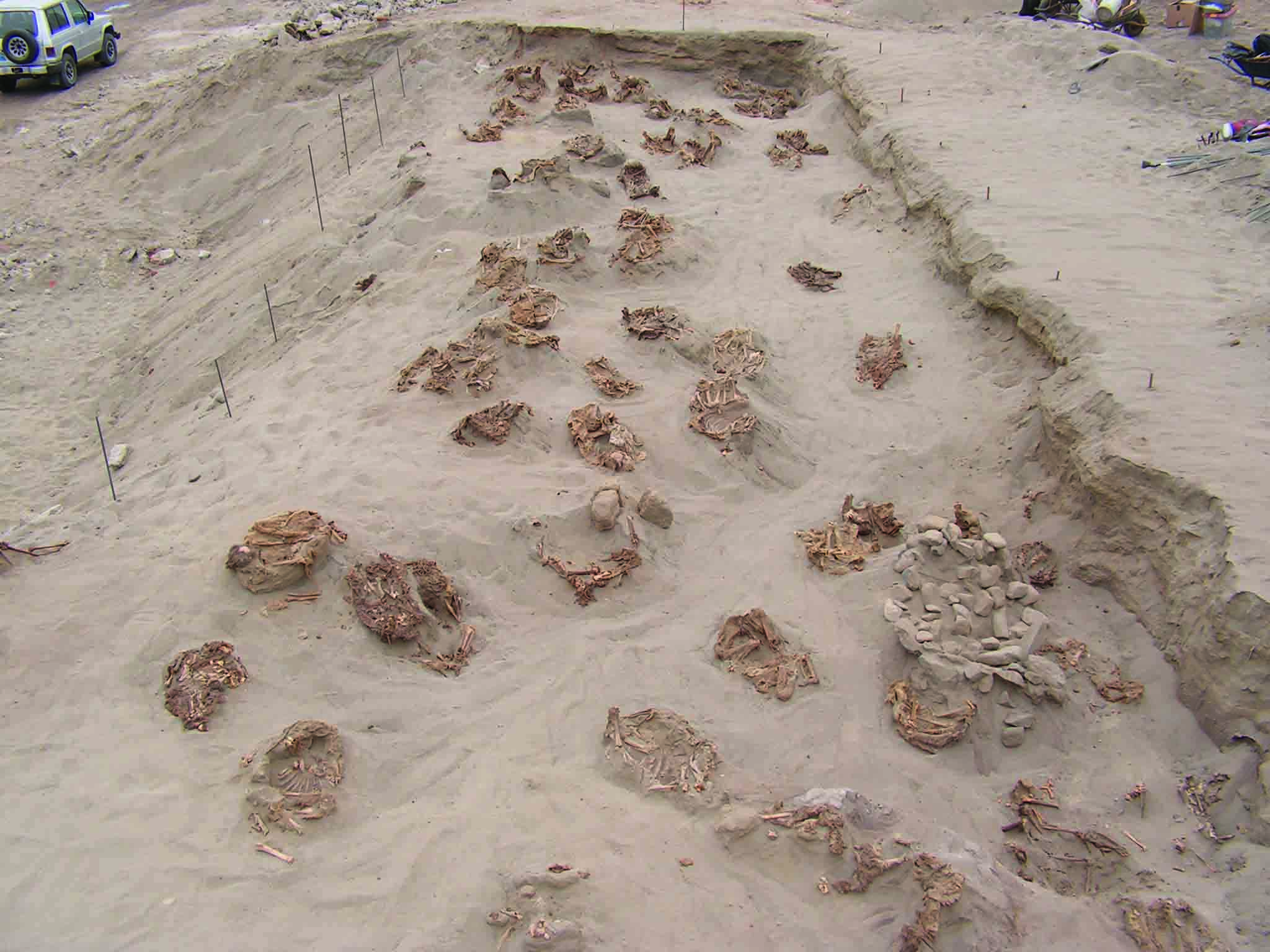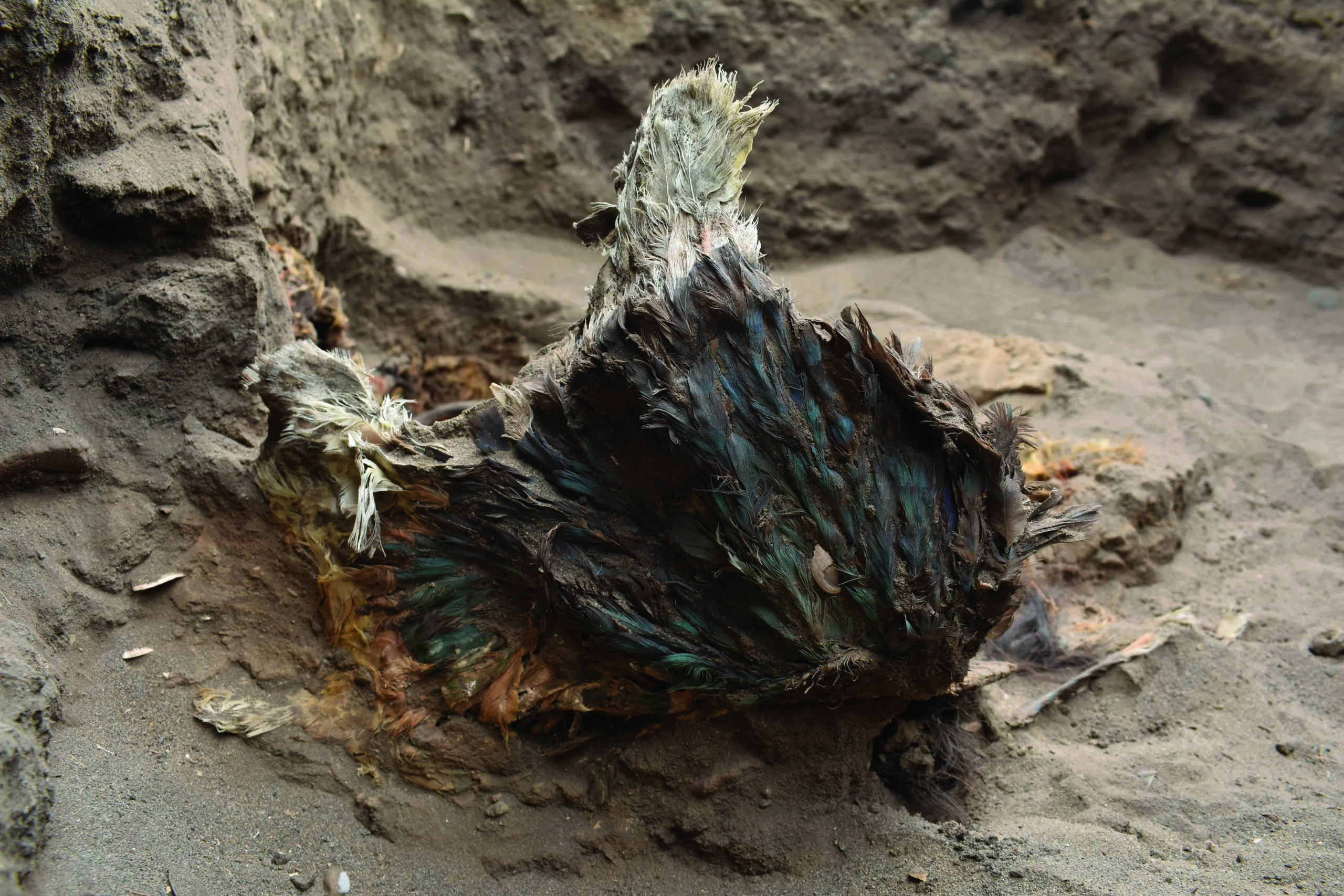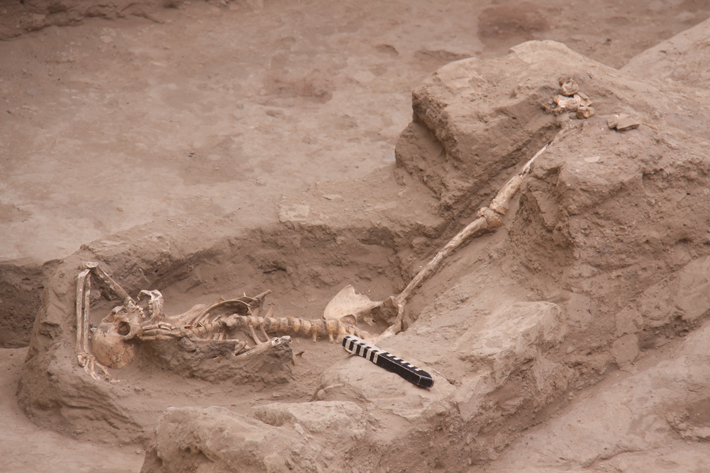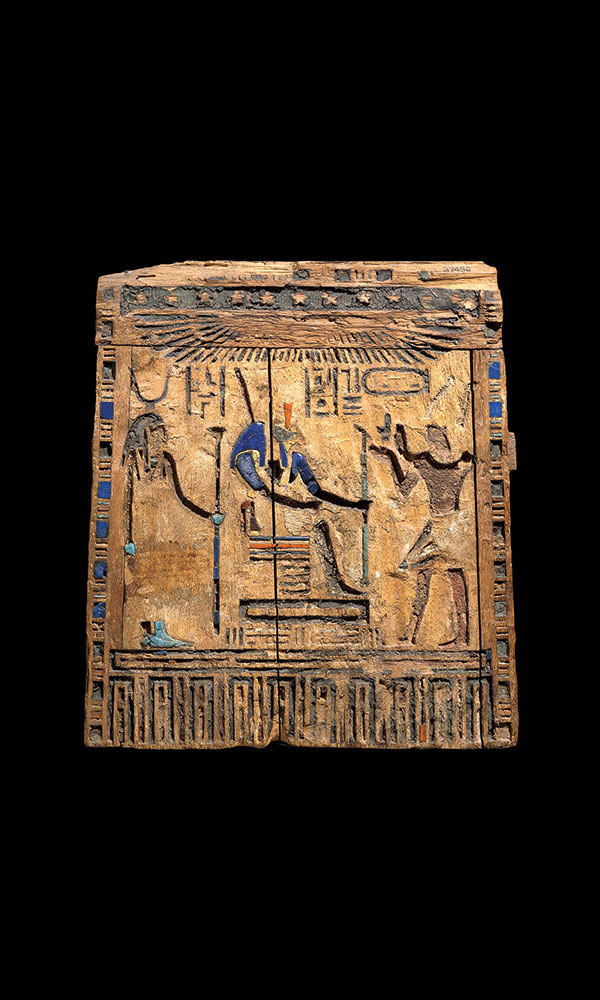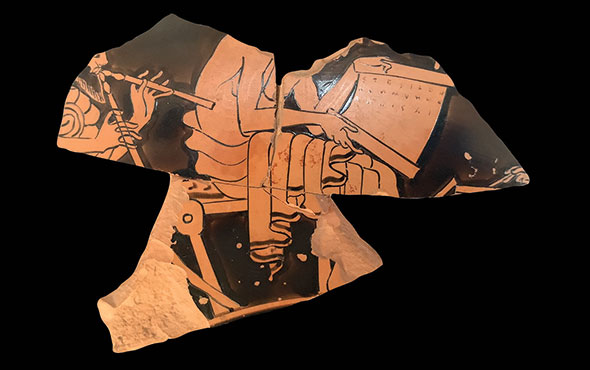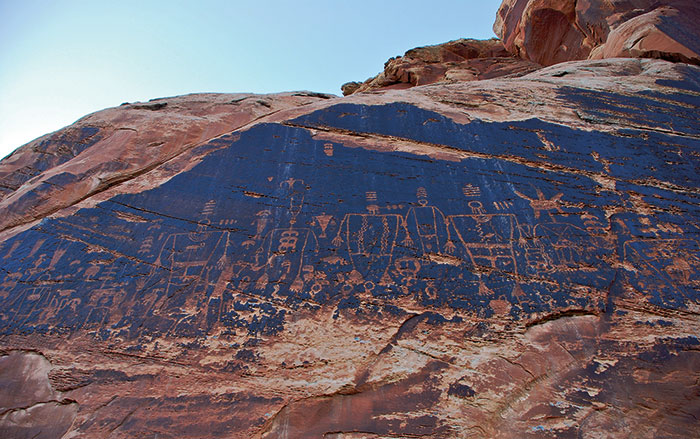
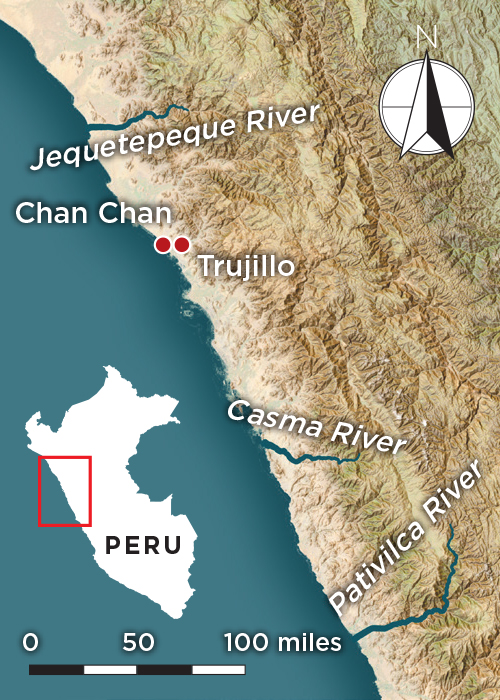
The Moche River Valley in northern Peru was an unlikely place to build a city. Though barely 1,000 feet from the Pacific Ocean, the valley received less than a tenth of an inch of rain per year. Nevertheless, in about A.D. 1000, a people known as the Chimú selected a location in the valley some four miles north of the river and set about making it habitable. Called Chimor in colonial accounts, and now commonly known as Chan Chan, it became the largest urban center in the Americas.
What enabled the Chimú to build a city in this unpopulated coastal desert was their tremendous engineering skill, which they used to create an extensive network of irrigation canals that channeled snowmelt from the Andes Mountains into the Moche River. What drove the Chimú was the desire for a place to call their own. The valley had no one to conquer and evict, no existing structures to raze, and no troubled history to erase. “Chan Chan is an invented city in an artificially irrigated valley,” says archaeologist Gabriel Prieto of the University of Florida. “The Chimú transformed the landscape, created an entirely new society, and became the most powerful rulers in coastal Peru. Chan Chan was an experiment that worked for almost five hundred years.”
The Chimú built their new capital, which spread over more than seven square miles, in a way that distinguished them from other Andean cultures and was intended to reflect their particular social system. “There were enormous social differences and a clear recognition of social distinctions in Chimú society,” says archaeologist Jerry Moore of California State University, Dominguez Hills. “What is so important about Chan Chan is that it shows a very different kind of architectural style from other Andean societies.” Even their myths reveal how, for the Chimú, division between classes was at the center of their worldview. One myth says that royal and noble males were spawned from a gold egg, noblewomen from a silver egg, and everyone else from a copper egg. “I like the egg myth because it suggests that the Chimú understood that social and political inequality is ‘baked in’ to humanity from the beginning,” says anthropologist Robyn Cutright of Centre College.
EXPAND
Where the Coca Grows
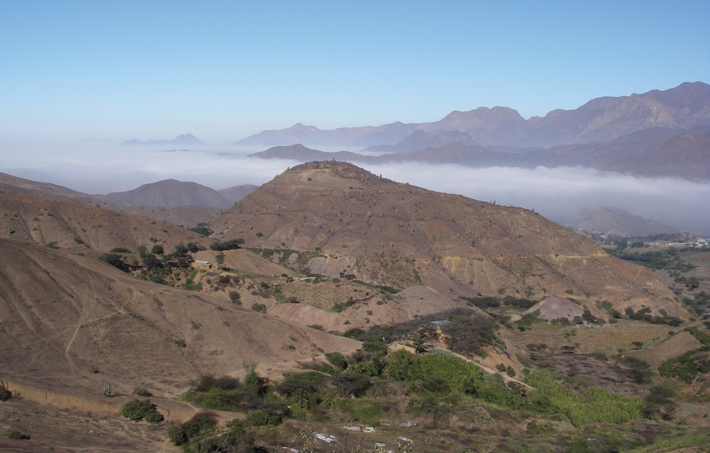
About 25 miles from Chan Chan in the foothills of the Andes on the easternmost edge of the Kingdom of Chimor sits ancient Collambay, a small village where excavations have unearthed some of the best evidence of how the Chimú interacted with the people they came to control. Collambay is in a small climatic zone called the chaupiyunga, an especially sunny area between the coastal valleys and the highlands that is the only place on the western slopes of the Andes suitable for growing coca, one of Andean peoples’ most precious crops. “Everyone needed access to coca for ritual, political, and social purposes,” says archaeologist Alicia Boswell of the University of California, Santa Barbara.
During excavations at Collambay, Boswell unearthed pottery assemblages that include a mix of styles—Chimú, highland, and locally made ceramics influenced by Chimú designs. She has also excavated graves in which highland burial practices were evident, but has found no Chimú-style burials. This, she says, suggests that the Chimú did not overwhelm those living in the region by force or by moving large numbers of Chimú people into town and forcing locals to emulate their traditions. Instead, they devised a different way to coexist and maintain a consistent supply of coca and other prestige goods, such as feathers from the Andean jungle and gold and silver ore from the highlands. “I haven’t found that all of a sudden everyone living in Collambay was Chimú,” says Boswell. “Instead, the Chimú worked with the local people, so everyone benefited. I think this is a great example of a contested landscape where people found a way to negotiate their relationship and control trade through the area. Perhaps, because they were so close to Chan Chan, these people were willing to cooperate and witnessed the growing power of the Chimú.”
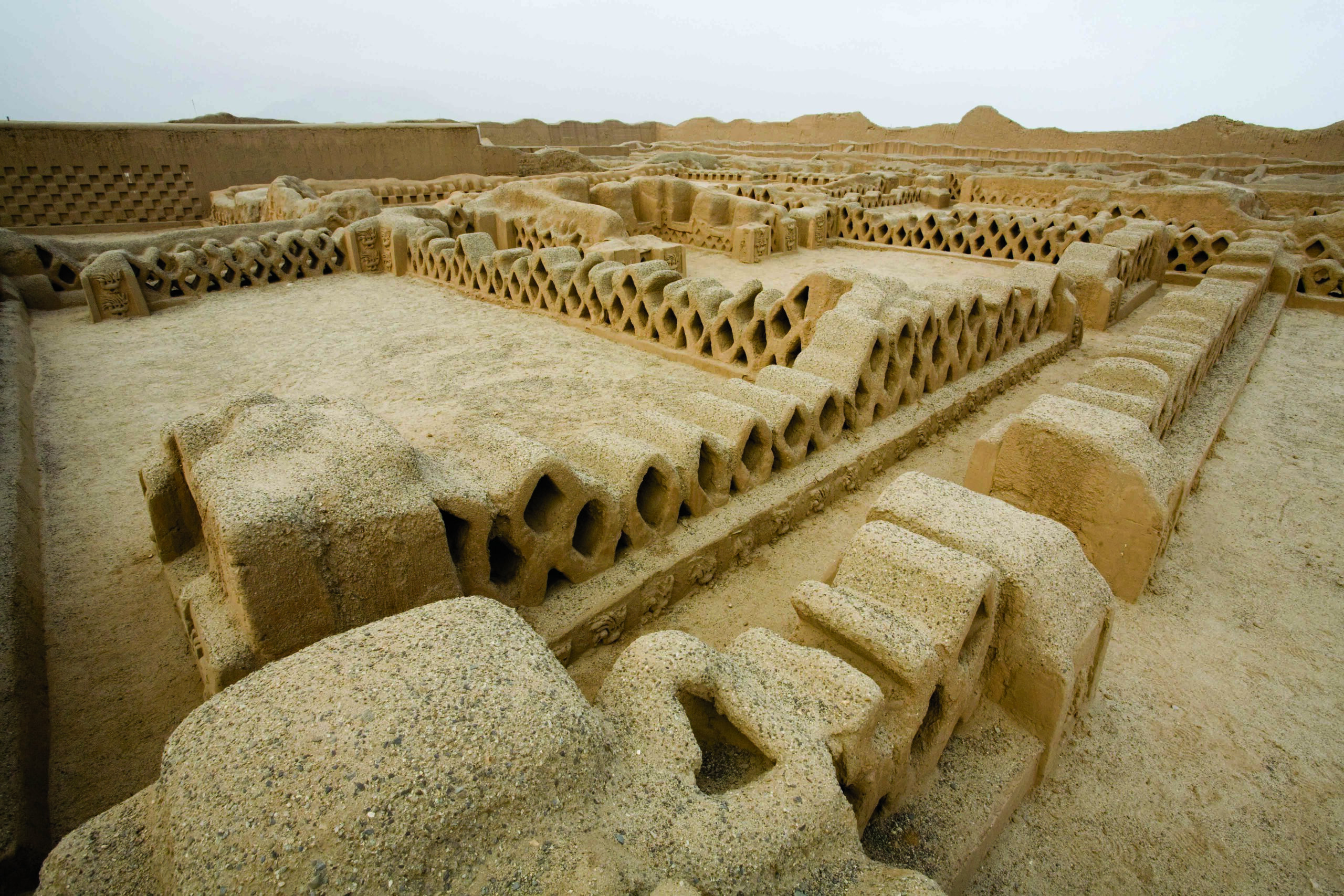
The first large-scale explorations of Chan Chan were conducted between 1968 and 1974 by members of the Chan Chan–Moche Valley Project, a massive mapping effort that investigated both the city’s monumental architecture and houses believed to have belonged to the urban working class. In the city plan that emerged, the researchers determined that Chimú kings lived in self-contained adobe royal palace complexes in a dense urban core of about two and half square miles. Each of the nine palaces had a single entrance that strictly controlled access to a zone of twisted, winding corridors leading to a royal residence with kitchens and wells, storerooms overflowing with the king’s treasure, and open plazas to hold feasts, ceremonies, and royal funerals. Many of the walls were covered with depictions of pelicans, fish, marine motifs, and Chimú deities. Seven palaces contained burial platforms intended for the deceased ruler.
The palaces were surrounded by walls up to 30 feet high. When a king died, his successor would build a new palace. “Each king or ruler constructed his own palace,” says Cutright. “There must have been some idea that succession required something new, not just inheriting the old.” Other members of the royal elite lived in smaller adobe compounds that included many of the same structures as the palaces, but on a much smaller scale. Chan Chan’s commoners, it was thought, lived and worked in small wattle-and-daub structures in four neighborhoods spread across the city. “The sharp social stratification of Chimú society is very clear in the architecture,” says Joanne Pillsbury, curator of ancient American art at the Metropolitan Museum of Art. “There are extreme differences in the scale and quality of building materials and ornament.”
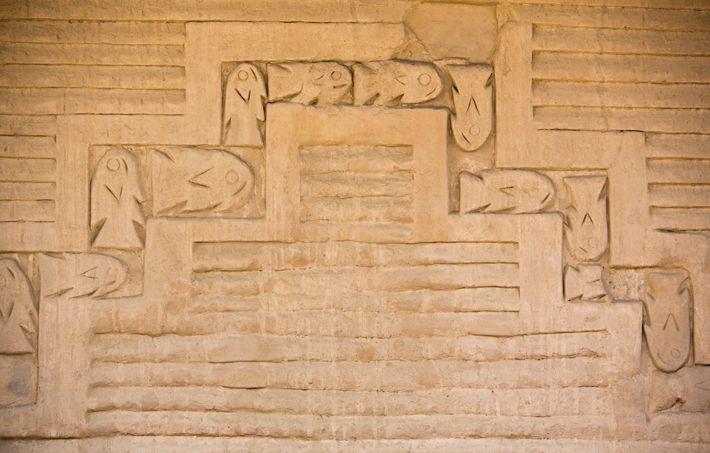
For much of the last five decades, there has been little investigation of Chan Chan. “Chan Chan is greatly understudied considering its importance,” says Tulane University biological anthropologist John Verano. An exception has been ongoing excavations conducted by the Peruvian Ministry of Culture that began in 2006 and have focused on the palaces and especially the funerary platforms, or huacas. For the past several years, archaeologists have excavated the imposing Huaca Toledo on the east side of the city, which, sixteenth-century sources report, once contained an enormous treasure of gold and silver belonging to the Chimú king. During the recent excavations, the team discovered fine tapestries and decorated ceramics, evidence of important burials once placed in the platform.
In 2022, Prieto returned to Chan Chan to excavate the neighborhood on the southwest side of the city and reexamine how average residents had lived. “We thought we knew that these types of neighborhoods were inhabited by artisans and craft specialists—silversmiths, weavers, wood-carvers—from a low social class who worked full-time for the needs and desires of the Chimú kings and queens,” he says. “But archaeology changes all the time and there are new techniques and new things to learn.” Thus far, the discoveries Prieto and his team have made have begun to upend the traditional view of the neighborhoods and redefine who lived in Chan Chan. They have found that these areas were much more ethnically diverse than previously believed and, in some cases, the people much better off. The work has also suggested that some families in the neighborhoods may have filled a special role in Chimú society. Prieto believes that some of the children who were sacrificed during one of multiple mass sacrifice events that are known to have occurred in Chimú history were either born in or moved to Chan Chan before these ceremonies, which were crucial to how the Chimú envisioned the world and their place in it.
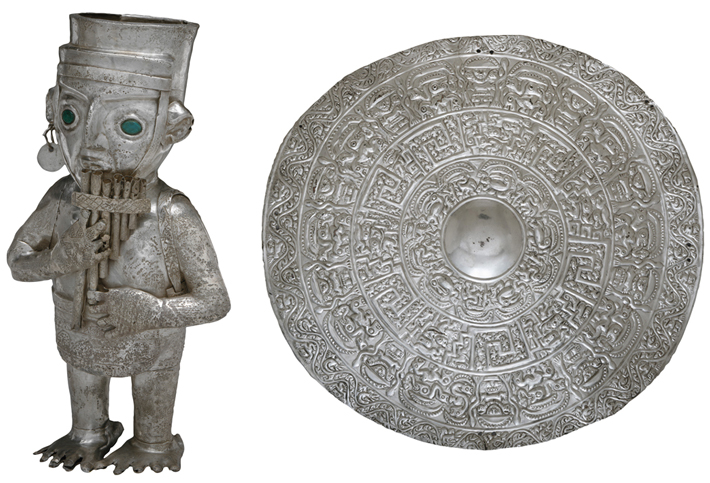

The Chimú were successors to the people of the Moche culture, whose rulers controlled much of northern Peru from about A.D. 200 to 900. According to the 1604 Anonymous History of Trujillo, written by a Spanish chronicler who recorded Chimú oral histories, the first Chimú king was Taycanamo, who came to the Moche Valley from the sea, having sailed there on a raft made of balsa logs, a design typical of the north. But the idea that the Chimú founder came from elsewhere may be more myth than reality. “The Chimú are the same people who have lived on the coast of Peru for as long as there have been people living there,” says Cutright. “There’s no evidence of any major population replacement, and instead we should think about shifts in political organization and cultural identity.” Once new generations started to call themselves Chimú, Prieto says, they tried to detach from the past and wipe the slate clean. “Chan Chan doesn’t emerge out of nowhere, but is distinctly and consciously different from Moche or anything else before,” says archaeologist Alicia Boswell of the University of California, Santa Barbara. “These people were reinventing how to express their novel ideologies and societal structures, and what we see, for example with the palaces, is a choice about how to present themselves as different and distinct from any culture before them.”

By the mid-fifteenth century, the Chimú territory, known as the Kingdom of Chimor, stretched about 600 miles along the coast from the Lambayeque Valley in the north to the Pativilca River in the south. Throughout the region, the Chimú used their irrigation expertise to maximize the production of cotton, maize, squash, lima beans, chili peppers, gourds, sweet potatoes, peanuts, avocados, and other fruits including guanabana or soursop, which, archaeological evidence indicates, seems to have been one of their favorite foods. They also ate llamas and guinea pigs and took great advantage of ample resources harvested from the sea. “I don’t think the Chimú could have survived without the sea and the marine riches available to them,” says Cutright.
The crops grown in the regions the Chimú took over were not new to the subjugated people, but the output required by their new rulers probably was. Much of these agricultural products fed and clothed the royal family and Chan Chan’s enormous population, which, in the mid-fifteenth century, reached upwards of 40,000. The city dominated the Moche Valley to such an extent that archaeologists have excavated only one Chimú rural settlement there. “It’s almost like the urban center of Chan Chan had a centripetal force drawing everyone to it,” says Moore.

The Chimú were master craftspeople, and it is thought that perhaps as many as 12,000 artisans in the city at its height were engaged in craft production. The Chimú required large quantities of precious metals to fashion jewelry, vessels, and ceremonial weapons, some of which were decorated with mother-of-pearl and turquoise. In addition to raising their own macaws in Chan Chan, they imported macaw and tanager feathers from the Peruvian jungle to create vivid crowns and to decorate cotton and llama-wool textiles. “These finely made gold and silver vessels, glittering ornaments, and exquisite textiles were essential in the maintenance of political authority,” says Pillsbury. The Chimú also imported Spondylus shells—some of the best were from present-day Ecuador—prestige items that were carved into ornaments and beads and crushed to create a powder that was scattered in front of the king as he walked.

Chimú rulers’ desire for wealth pushed them to expand their territory and form relationships in search of new sources of food, raw materials, human capital, and tribute from the people under their control. They established provincial administrative centers at sites including Farfán in the Jequetepeque Valley and Manchan in the Casma Valley. Unlike some ancient empires, though, not all Chimú expansion was achieved through military might. “Even if there are goods that you want, that are desirable, it doesn’t necessarily mean you have to have an entire militarized acquisition system to get them,” Moore says. “I don’t think those rare objects or materials were always obtained through conquest.” (See “Where the Coca Grows.”)
After nearly five centuries, in about 1450, Minchançaman, the eleventh and final ruler of the Kingdom of Chimor, was defeated by the Inca ruler Tupac Yupanqui and imprisoned in the Inca capital of Cuzco. Apart from brief mentions of the Chimú in the Anonymous History of Trujillo, almost nothing is known from any written source about the Chimú style of government or religious beliefs. By the time the Spanish arrived, their language, Quingnam, had almost completely disappeared and is now extinct. And archaeologists have focused their efforts in the region more on the Moche and Lambayeque, two of the peoples whose territories the Chimú controlled. “The Chimú are missing the party of prehistory,” says Prieto. “They haven’t been invited yet.”
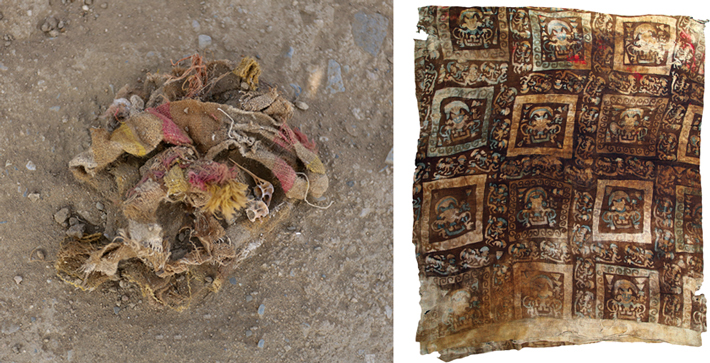
When Prieto began his excavations, scholars believed that the city’s four residential neighborhoods had been filled exclusively with craft workshops, but little evidence of this had been found. Prieto says he was skeptical. Soon his team began to uncover evidence that the residents of the neighborhood they were working in held a higher socioeconomic position than that which artisans would be expected to have. Inside the two houses they have excavated thus far, they have unearthed luxury goods including macaw feathers, Spondylus shells, fine textiles, and metal objects. But Prieto has yet to unearth any solid evidence of sustained craft activity. “Based on the quantity and quality of the material we found in the residences, it’s very clear that these aren’t workshops,” he says. “These were by no means lower-class Chimú people and were definitely members of an intermediary elite not attached to royal families.” Although the team has found a great number of cotton items as well as spindles and needles in the houses, Prieto is uncertain whether the textiles were produced for household use or for the rest of the city as well.
In addition to the startling wealth Prieto’s team uncovered, he also found something else unanticipated. “I was expecting to find classic, simple Chimú wares used by people in the Moche Valley,” he says. Instead, he found ceramics from the Casma and Jequetepeque Valleys and from the Lambayeque region to the north, which may have been brought to Chan Chan by people who relocated to the city. “We knew the Chimú were conquering these regions,” Prieto says, “but we didn’t know they were incorporating people from these areas into the big city.” Macrobotanical evidence has also contributed to a new understanding of who was living in Chan Chan. The team has found remains of nonlocal foods such as quinoa, potatoes, and sauco, or elderberry, which are typical of the highlands. The textiles they have discovered also show an unexpected variety of weaving techniques and decoration. “We’re now thinking that the population in the city was much more diverse than previously thought,” says Prieto. “The way I see Chan Chan now is that it was full of people expressing their identity with different customs, different types of food, and different clothes.”
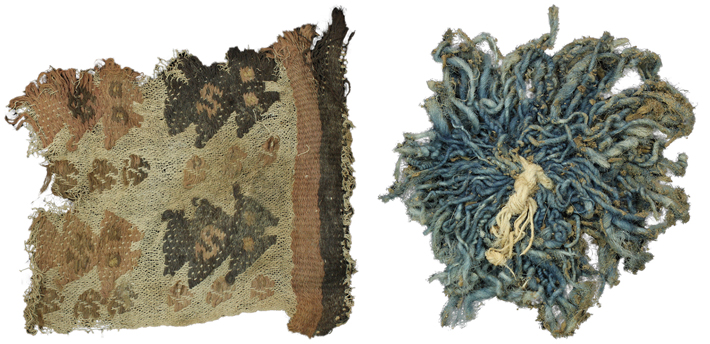
The houses Prieto and his team have excavated are directly across the street from each other, but have very different layouts, surprising for a society understood to be so dominated by those at the top. Each house measures between 850 and 1,000 square feet, but one, called House Eight, has a complex plan with more rooms, while the other, House Seven, is much simpler. “The houses aren’t cookie-cutter residences built in a certain way because the state tells you to,” Prieto says. “These people had liberty to build their homes as they wished.”

Chan Chan grew in ways that did not adhere to a single overarching plan, but according to the changing needs of its residents. “Every time the Chimú expanded their territory and brought new people into the city, it had to accommodate more people, more ways of getting around.” Prieto says. “We see this in the archaeology even in just this one little neighborhood.” The team has found that the neighborhood’s history of occupation had at least three different phases and that modifications were made at each stage. “That leads me to think that whatever was going on at the domestic level was affected by major changes in the political organization,” says Prieto. “Maybe when they built a new palace, the ruler said that everyone had to change their own house, too.” Radiocarbon dates show that the last two levels of both houses date to after 1450, and possibly as late as 1470, well into the Inca period, after Chan Chan was thought to have been abandoned. “This is something that had never been known before,” says Prieto, “and we already have a much more complex understanding of the city than we ever thought possible.”

The power of Chan Chan’s rulers was not limited to the city’s palaces and neighborhoods. From 2011 to 2022, Prieto and Verano excavated the sites of Huanchaquito-Las Llamas, Pampa la Cruz, and El Pollo about six miles north of Chan Chan. They uncovered the remains of 451 sacrificed girls and boys ranging in age from five to 15, 36 sacrificed adults, most of whom were women, and 620 sacrificed llamas, all of which were juveniles. (See “A Society’s Sacrifice.”) Verano and other scholars have studied the children’s remains and learned that they all died in the same manner. “We see that they were sacrificed in a consistent way,” Verano says. “They weren’t bound or tied up like captives, they didn’t suffer any blows to the head, and most of the time we can identify a single horizontal cut through the sternum—a few do have hesitation cuts, perhaps made by someone less skilled—and likely the removal of their heart.” All the llamas were killed using the same process, a method that is still practiced in the Peruvian highlands today.
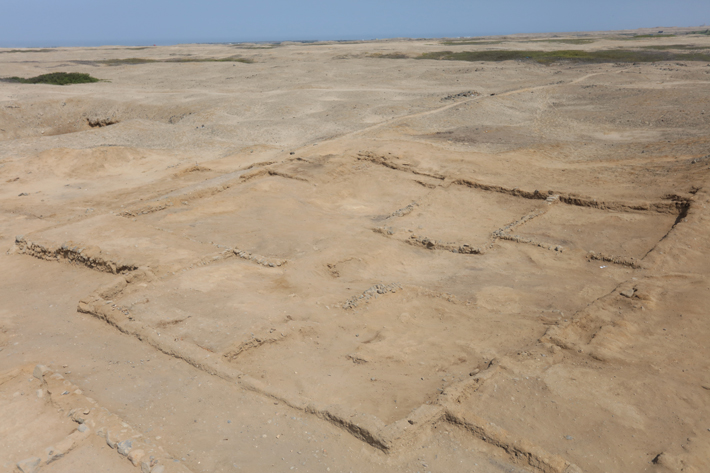
The only historical mention of Chimú child sacrifice is an account by a Spanish friar, Father Antonio de la Calancha, who wrote that the Chimú conducted child sacrifices during lunar eclipses. No such descriptions of Chimú mass sacrifices exist in either the records of the Inca or other Spanish chroniclers. “Unlike the very well-documented high-altitude Inca child sacrifices, called the capacocha, we don’t have any ethnohistoric descriptions of these events or the motivations or procedures accompanying them,” says Verano. “Before our discovery, this phenomenon was invisible to archaeologists.” Furthermore, Chimú art does not include images of human sacrifice. “This is completely unlike their predecessors the Moche,” says Boswell, “whose iconography is filled with vivid scenes of male warrior sacrifice.” This change is further evidence of the break from the past the Chimú seemed intent upon. “We have no firsthand accounts of Chimú ritual practices, just the archaeological remains suggesting certain activities along with later accounts describing some practices,” says Pillsbury. “Sometimes works of art can help illuminate things. For example, Moche artists excelled in creating terrifying, snaggle-toothed beings, often engaged in cosmic struggle, but you don’t see those subjects often in Chimú art, and this suggests a change in belief and practices.”

At first, Prieto and Verano thought that the children were part of a single mass sacrifice at the various sites, perhaps connected to an El Niño weather event in 1450, but radiocarbon dates showed that there were, in fact, multiple sacrificial ceremonies beginning in about 1050 and continuing for the next 400 years at the three different locations, extending into the Inca period. “This was a series of ritual events performed as a way to communicate with the gods and mediate between people and supernatural forces,” says Verano. Ritual ceremonies of this level of standardization and complexity must, he says, have been organized at a state level and been tightly controlled by the kings at Chan Chan.
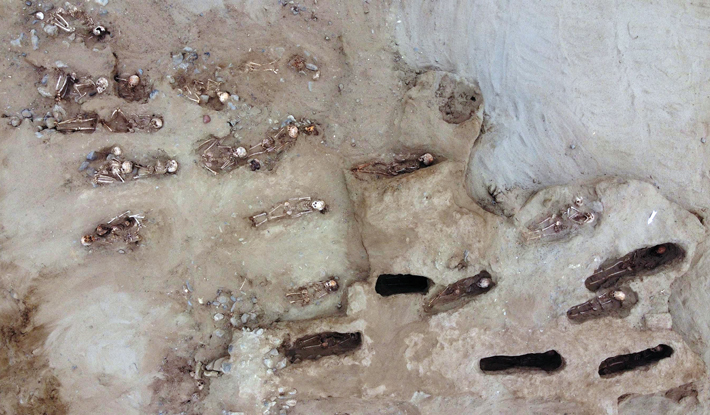
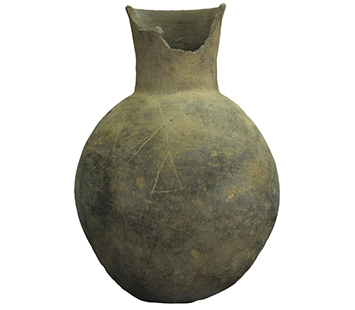
Prieto wanted to investigate where the children came from and what kinds of lives they led. A member of his team, bioarchaeologist Rachel Witt of Tulane University, conducted oxygen isotope analysis on the remains of 30 children from Pampa la Cruz and El Pollo to determine where they were born and grew up. Her work showed that 63 percent were not born in the Chimú imperial core in the Moche Valley. More than half of the children exhibit oxygen isotope values that fall outside the range of values for the water they would have drunk in the Moche Valley, suggesting that they were born outside the valley and lived there throughout infancy. “These children were drawn from many different communities, not only in the Moche Valley, but also from other valleys, and maybe even from farther inland than you would expect,” Witt says. “Perhaps this was done in tandem with Chimú imperial expansion to get everyone to buy into their worldview and the power of their empire, and they used coercive force to achieve that.”
Witt also examined a number of the children’s skulls from El Pollo and found that 52 percent had a type of cranial modification typical of locations across the north coast of Peru: a flattening of the back of the head that is a result of women carrying infants in cradleboards strapped to their backs. At least one of the children studied had a distinct form of cranial modification typical of the northern Andean highlands, which, says Witt, is rare to see in coastal communities. “The Chimú had the ability to draw on a large terrain, and I think they were reaching out to diverse regions to find children for the sacrifices,” says Verano. “Some may have been brought there specifically or they may have immigrated from the highlands and come to live near the capital. It reminds us to think of Chan Chan as a cosmopolitan city that controlled large parts of Peru.”
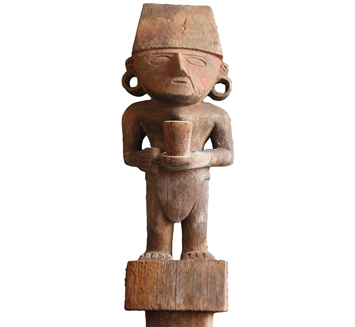
Prieto believes that some of the children may have grown up with their families in the neighborhood he is excavating or moved there from locations across the empire. “The child sacrifices were such an important part of Chimú society that it makes much more sense that they were raised in a fancy neighborhood in Chan Chan than in a little fishing village like Huanchaquito,” he says. The team also found that the sacrificed children showed no signs of malnutrition, enslavement, or captivity. “These families were not lower class,” Prieto says. “They had a good diet and good health, and this says something about who was living in these neighborhoods.
Despite their revered place in Chimú society, the children were not interred in a large temple or atop a platform hidden in a palace. Instead, they were laid to rest in the valley near the ocean, the Chimú’s legendary place of origin, at locations where many people could have watched the ceremony. Most of the children were buried facing northwest, toward the ocean, and the llamas were buried facing toward the mountains—an important way, Verano says, of marking the relationship between the land and the sea and Chan Chan. “The foundation myth of Chimú civilization is that they came from somewhere else,” says Prieto. “In Chan Chan, they wanted to start all over again and create a new dynasty, and the sacrificed children played a major role in this. I think the sacrifices created new kinds of bonds within their families without any kind of political baggage rather than claiming connections to old ancestors. In carrying out the sacrifices, and by bringing them into these new spaces, they transformed this arid landscape into a green expanse that would provide for them. By sacrificing the children and burying them, they were, in a way, planting new ancestors.”



